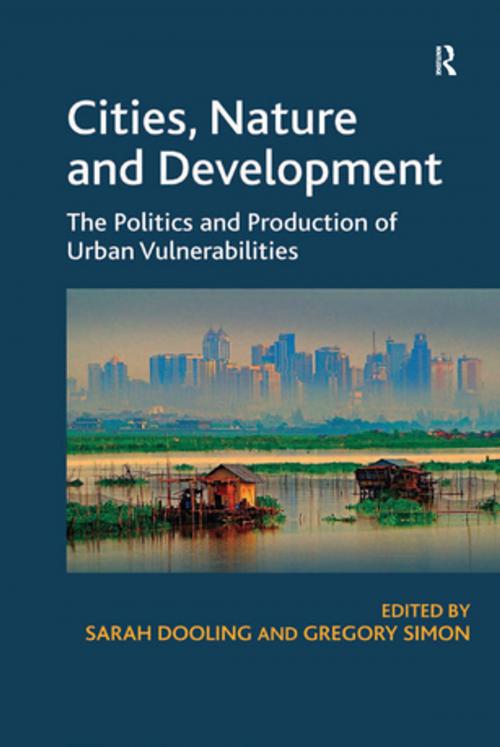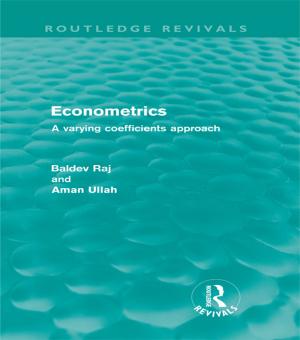Cities, Nature and Development
The Politics and Production of Urban Vulnerabilities
Nonfiction, Social & Cultural Studies, Social Science, Human Geography| Author: | Sarah Dooling | ISBN: | 9781317165965 |
| Publisher: | Taylor and Francis | Publication: | May 23, 2016 |
| Imprint: | Routledge | Language: | English |
| Author: | Sarah Dooling |
| ISBN: | 9781317165965 |
| Publisher: | Taylor and Francis |
| Publication: | May 23, 2016 |
| Imprint: | Routledge |
| Language: | English |
Bringing together an interdisciplinary team of scholars, this book illustrates how and why cities are comprised by a mosaic of vulnerable human and ecological communities. Case studies ranging across various international settings reveal how 'urban vulnerabilities' is an effective metaphor and analytic lens for advancing political ecological theories on the relationships between cities, nature and development. Contributions expand upon conceptions of vulnerability as a static condition and instead present vulnerability as a phenomenon that is produced through complex and contentious planning histories, and which may, in turn, be politicized, exploited and-in some instances-contested. Expanding upon snapshot vulnerability assessments, this volume articulates vulnerability as a process that is marked by the accumulation of risk over time and the transference of risk across space and populations. Moving beyond notions of vulnerability as a singular, case studies demonstrate that social and ecological vulnerabilities are deeply integrated and, as such, are irreducible to one or the other. This volume also highlights how the production of vulnerabilities is frequently achieved through integrated and mutually reinforcing economic development and environmentally driven agendas. This collection thus suggests that vulnerability-and also forms of resilience-are implicated in efforts to plan for and manage sustainable cities. This book provides timely and provocative perspectives on a wide range of urban issues including: park management, gentrification, suburban expansion, sustainability planning, local organic food systems, hazards management, climate change activism and north-south flows of urban environmental externalities. Collectively, these works reveal the complexities of urban vulnerabilities-related to scalar interactions, accumulation and transfer of risk, politicization and governance, and capacity for resistance-and in doing so, provide readers with coherent, robust and well-theorized analysis of the politics and production of urban vulnerabilities.
Bringing together an interdisciplinary team of scholars, this book illustrates how and why cities are comprised by a mosaic of vulnerable human and ecological communities. Case studies ranging across various international settings reveal how 'urban vulnerabilities' is an effective metaphor and analytic lens for advancing political ecological theories on the relationships between cities, nature and development. Contributions expand upon conceptions of vulnerability as a static condition and instead present vulnerability as a phenomenon that is produced through complex and contentious planning histories, and which may, in turn, be politicized, exploited and-in some instances-contested. Expanding upon snapshot vulnerability assessments, this volume articulates vulnerability as a process that is marked by the accumulation of risk over time and the transference of risk across space and populations. Moving beyond notions of vulnerability as a singular, case studies demonstrate that social and ecological vulnerabilities are deeply integrated and, as such, are irreducible to one or the other. This volume also highlights how the production of vulnerabilities is frequently achieved through integrated and mutually reinforcing economic development and environmentally driven agendas. This collection thus suggests that vulnerability-and also forms of resilience-are implicated in efforts to plan for and manage sustainable cities. This book provides timely and provocative perspectives on a wide range of urban issues including: park management, gentrification, suburban expansion, sustainability planning, local organic food systems, hazards management, climate change activism and north-south flows of urban environmental externalities. Collectively, these works reveal the complexities of urban vulnerabilities-related to scalar interactions, accumulation and transfer of risk, politicization and governance, and capacity for resistance-and in doing so, provide readers with coherent, robust and well-theorized analysis of the politics and production of urban vulnerabilities.















